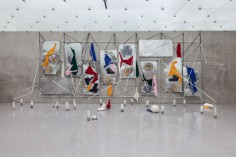yorgos sapountzis

source: artnewsorg
Order and Chaos
Sapountzis’ interest in experimenting with sculpture and its impact and signification in public space roots perhaps in the richness of antique monuments in his native city of Athens. The constant confrontation with his cultural heritage also accompanies in his video-installation that he created for his nomination of the 2009 DESTE Prize at the Athens Museum of Cycliadic Arts. For the video The Heritage of its Architecture (2009) Yorgos Sapountzis had himself filmed at night inside the museum by surveillance cameras while constructing a new installation of colored cloths and aluminum tubes between the vitrines with pre-historic sculptures. Sapountzis mixed the video of the surveillance cameras with his own recordings: quickly altering perspectives blend with the reflections of cycliadic vases and figures in the glass of the vitrines and the color plains of the cloths. Hard electro sound amplifies the confusions of the view.
For the presentation of the film Sapountzis built a tent-like construction of colorful cloths and projected the video onto two walls of fabric. Doing so, the nightly performance, the video and the installation aggregate to a single complex system in which forms repeat and reformat, pre-historic objects meet the formal vocabulary of modernism. This might appear chaotic at first glance. But through almost choreographed movements Sapountzis creates new combinations and motion sequences: “I create chaos to create order.”
In fact, Sapountzis’ diverse bodies of works are interconnected, they condition one another and evolve: the installations are formed through their function as displays for the video projection or remain as a relict of a performance and the videos again are recordings of the performances. Also, the colorful, handmade posters made of painted newspapers that he embroiders with letters serve as announcements of a performance or an exhibition.
Techné
In the making of all of Sapountzis’ works handcraft is a distinctive factor. Sapountzis applies material that he can work, install and transport himself. The originally Greek term of τέχνη (techné) [tékʰnɛː]- the ability, artifice, craft – does not distinguish between today’s categories of art and technique. In Sapountzis’ works the technique the medium is often constitutive of the form: e.g. in the use of serveillance or web cameras for the recording of his performances at night, in the construction of projection screens for the videos, in the electronic music that accompanies his films (and performances). Yorgos Sapountzis has also developed a group of aluminum-paper sculptures from the form of bicycle frames. For all his works he repeatedly uses the same materials: colored cloths, aluminum or elastic plastic tubes, adhesive tape, string, newspaper. All these materials share certain qualities: they are light, flexible, ductile, their volumes can be reduced, they are easily transportable. Materials that can be moved with the human body – fabrics and ribbons – used for example by gymnasts for their exercises.
Eternity and Lightness
Accordingly the materials in a certain way become determinant of the structure of the performances:
“ When I effect a performance, there are always several elements- eg the materials – that are clearly defined from the beginning. Between those I try to react, make contact with the audience and use the creativity of the moment.” The performances of Yorgos Sapountzis resonate with the idea of a dance, a procession, a poem: a dance because the movements are subject to rhythm, repetition, constitution of form, steps, luffing, nodding – going back and forth. A procession because the viewers are included: newspaper hats, colored gowns or aluminum tubes are distributed, as in the performance The Distances Between Teeth and Street that Isabella Bortolozzi Gallery, Berlin presented 2010. For Field Trip, 2010 – an exhibition in the form of a promenade through the Humboldt University Berlin, Sapountzis handed out branches and limbs of trees so that the procession
moved like a wandering forest through the halls, aisles and corridors of the university. Of a poem as the performances bundle an immense concentration, as well as the condensation and the tension that arises from the voidage.
In the spontaneous appropriations and occupancy of the public space and in the undermining of existing structures and authorities, one can find parallels to certain forms of streetart may be seen: e.g. the way skateboarders, breakdancers or traceurs illegally use public space (and it’s monuments) for their jumps, turns and parkours.
Sapountzis achieves to create a tension, a connection between viewer and performer and the public space. With his performances he opens up a new perspective on common spaces and environments. Everyday movements and noises are noticed suddenly more delicately, spaces are redefined: “In my performances I’m always concerned with building something, constructing something. It is like the dance of the sculptor around his work of art.”
-Christiane Rekade
.
.
.
.
.
.
.
source: ifade
Yorgos Sapountzis (1976 in Athen geboren) geht in seinen Arbeiten oft von Monumenten und Strukturen des öffentlichen Raums aus, die er temporär und kollektiv aktiviert. Die Performances werden aufgezeichnet und gehen mit dem textilen Material der Aktion installativ in den Ausstellungsraum ein. Im Video “Fast Cast Past” (2011) sieht man zwei Skulpturen des deutschen Bildhauers Richard Scheibe, die im Berliner Stadtraum stehen: die eine aus dem Jahr 1935 verkörpert einen “Herrenmenschen”, die andere stammt aus der Nachkriegszeit und steht an der Gedenkstätte für den Deutschen Widerstand im Dritten Reich. Die frühe Arbeit hat Yorgos Sapountzis in einer Performance mit farbigen Stoffen bedeckt und Abgüsse von ihr genommen, in der letzten Einstellung des Videos stellte er sich dann neben die zweite Skulptur.

